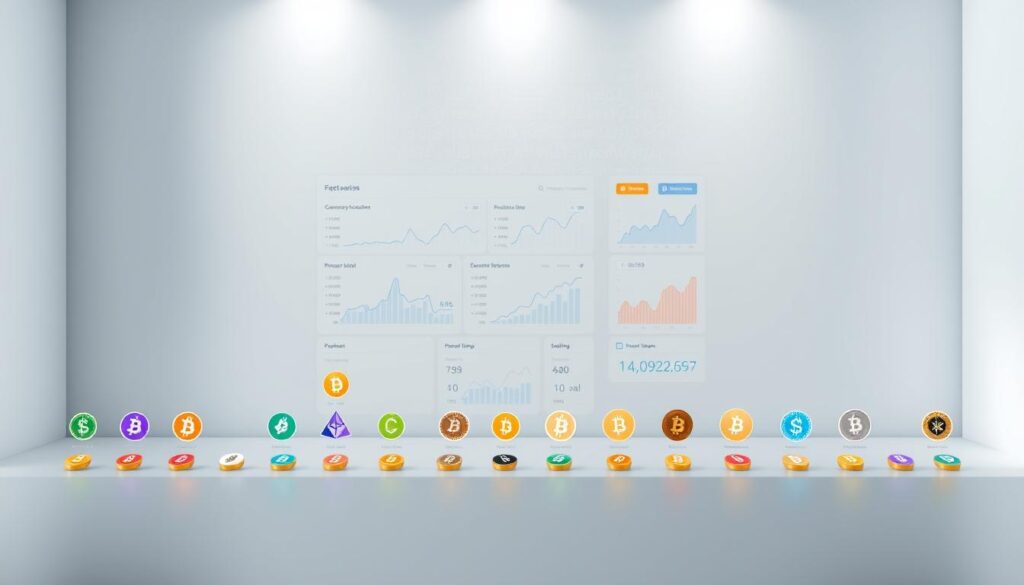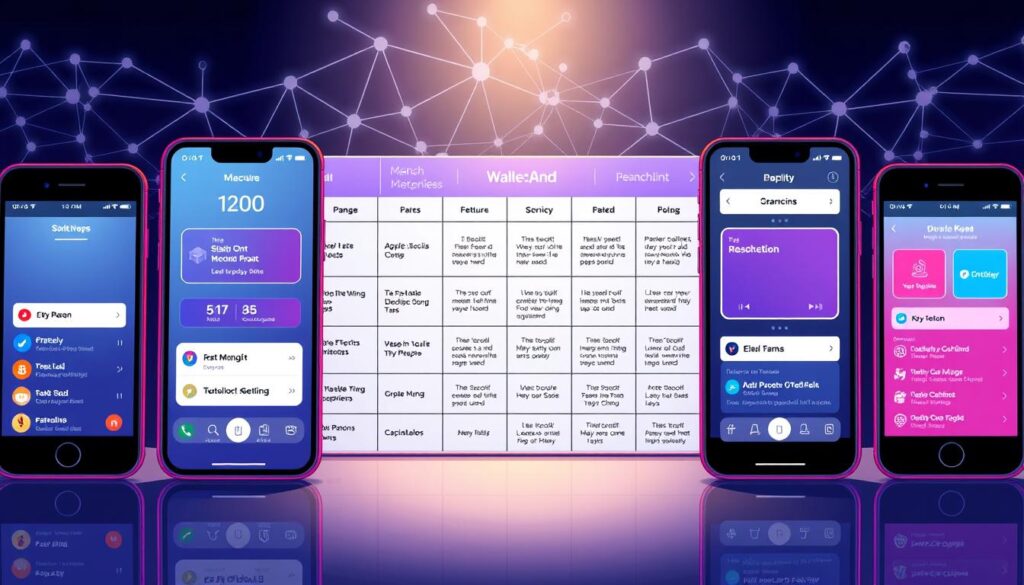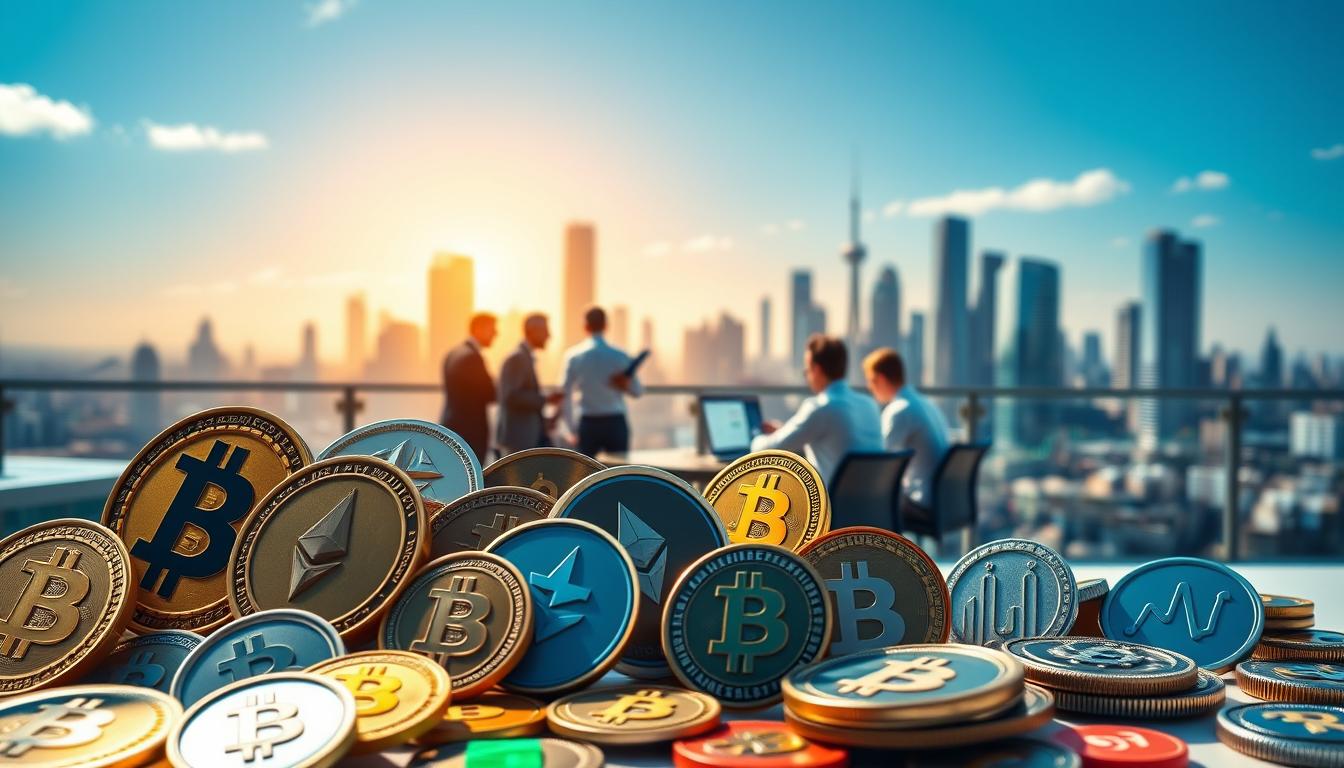Now Reading: A Beginner’s Guide to Blockchain-Based Digital Payments
- 01
A Beginner’s Guide to Blockchain-Based Digital Payments
A Beginner’s Guide to Blockchain-Based Digital Payments

Blockchain-based digital payments are changing how we send money around the world. This method is different from old banking systems. It uses blockchain technology for safe, clear transactions.
There’s no need for middlemen. People can send money directly, whether it’s for a coffee or an international payment. As more people use digital currency exchange platforms, sending money becomes quicker and cheaper.
Key Takeaways
- Blockchain-based digital payments eliminate high fees common in traditional banking.
- Blockchain technology ensures every transaction is recorded permanently and securely.
- Digital currency exchange platforms make it easier to convert crypto into fiat money.
- Users gain control over their funds without relying on banks or credit card companies.
- Adoption is rising as businesses and individuals seek faster cross-border payment options.
Understanding the Fundamentals of Blockchain Technology
Blockchain technology is key to modern digital transactions. It stores data on a network of computers, making it hard to change. This setup keeps transactions safe and honest.
What Makes Blockchain Different from Traditional Databases
Traditional databases have one person in charge. Blockchain, on the other hand, has a distributed ledger where everyone has a copy. Changes need everyone’s agreement, making it hard to alter data.
This makes secure online payments possible. Transactions are clear and can’t be changed.
The Role of Decentralization in Blockchain
Decentralization means no single person controls it. Nodes (computers) check transactions through complex math. This builds trustless systems where users deal directly with each other.
This is the core of blockchain payment systems. It makes transactions safer and cuts out middlemen.
How Transactions Are Verified and Recorded
Transactions start as unverified entries. Miners solve puzzles to confirm them. Once confirmed, they become blocks linked to others, creating a chain.
This ensures data is accurate. It’s the base for blockchain technology uses like cryptocurrency.
The Evolution of Digital Payments
Before, we used cash and checks for payments. But the internet changed everything. By the early 2000s, online banking and credit cards were common. Yet, they had problems like slow transactions, high fees, and limited reach.
The 2008 financial crisis made people look for better options. This need led to Bitcoin’s launch in 2009. It was the first blockchain-based digital payments system.
Crypto payments started to grow. Developers created networks like Litecoin and Ripple for quicker, cheaper transfers. Now, digital wallet solutions like MetaMask and Exodus make it easy to manage crypto. A 2023 report predicts crypto payments will reach $5 trillion by 2030, thanks to lower costs and easier international use.
More companies are starting to accept crypto. Starbucks and Tesla are among them. New technologies like the Lightning Network for Bitcoin and stablecoins help make payments faster and more reliable. Microtransactions using crypto are also becoming popular for small purchases and payments. This shows blockchain payments are more than just a trend—they’re changing the way we handle money.
What Are Blockchain-Based Digital Payments?
Blockchain-based digital payments use decentralized networks to transfer value without intermediaries. These systems rely on cryptographic security to ensure trust and transparency. Unlike traditional banking, every transaction becomes a permanent record on a shared ledger. Let’s explore how these systems work in practice.

Key Components of Blockchain Payment Systems
- Wallets: Secure digital storage for managing private keys and accessing funds.
- Addresses: Unique identifiers for sending/receiving assets (e.g., Bitcoin addresses).
- Tokens: Digital assets (like ETH or XRP) representing value within the network.
- Smart contracts: Self-executing agreements automating payment terms on platforms like Ethereum.
How They Differ from Traditional Methods
Traditional bank transfers often take days and charge high fees. Blockchain payment systems cut this down to minutes with lower costs. For instance, cryptocurrency transactions on networks like Litecoin offer faster confirmations than SWIFT. Security is built into the protocol, reducing fraud risks compared to credit cards.
Types of Blockchain Payments Available Today
- Cryptocurrency transactions: Direct transfers of Bitcoin or Ethereum between users.
- Stablecoin payments: Dollar-pegged assets like USDC for price stability.
- Lightning Network micropayments: Instant, low-cost payments on top of Bitcoin’s blockchain.
- Tokenized assets: Real-world assets (e.g., real estate tokens) traded as blockchain entries.
Whether settling invoices with crypto or using DeFi platforms, these systems empower users to control their funds directly—no banks required.
Benefits of Using Cryptocurrency for Transactions
Cryptocurrency transactions offer a new way to do things compared to old banking systems. They can save money and make things easier for both people and businesses. Here’s how:
Lower Transaction Fees Compared to Traditional Banking
Old ways of sending money across borders can cost a lot. For example, sending $1,000 via SWIFT might cost $30–$50 in fees, plus extra for exchange rates. But, crypto platforms like Ripple or Stellar charge less than $1 for the same job. Even better, some domestic crypto transactions are free.
This makes crypto payments great for sending money to other countries often. Like when people living abroad send money back home.
Enhanced Security Features
Crypto transactions are super secure. They use advanced encryption. Private keys are like digital signatures that only the owner can use to make payments.
Unlike credit cards, which store your info on servers, blockchain is spread out and can’t be changed. This lowers the chance of fraud. For example, Bitcoin’s ledger has never been hacked, unlike banks that get hacked a lot.
Secure online payments with crypto also mean you don’t have to share your bank info with stores. This lowers the risk of identity theft.
Global Accessibility Without Borders
More than 1.7 billion adults don’t have bank accounts. But, crypto wallets let anyone with internet access send or receive money easily. Platforms like BitPesa and Trust Wallet make it simple.
Businesses can also take crypto payments from customers anywhere in the world. This gets around money rules in different places. Even in areas with shaky local currencies, crypto is a solid choice for everyday buys and international trade.
Setting Up Your First Digital Wallet
Choosing the right digital wallet solutions is key to safe crypto payments. You can pick from software wallets like MetaMask, mobile apps like Trust Wallet, or hardware devices like Ledger. Each option balances security and ease of use:
- Hardware wallets: Physical devices for storing crypto offline (cold storage).
- Mobile apps: Easy-to-use for daily crypto payments.
- Web wallets: Accessible but require extra caution due to online storage.
- Download a trusted app or visit a provider’s official site.
- Create a unique password and store the recovery phrase in a secure physical location.
- Link the wallet to a digital currency exchange like Binance or Coinbase to buy crypto.
Always enable two-factor authentication (2FA) and avoid sharing recovery details. Hardware wallets like Trezor are great for long-term storage. Mobile wallets are better for frequent payments. Keep your software up to date to avoid security issues.
Remember: Your recovery phrase is irreplaceable. Losing it means you’ll lose your funds forever. Choose wallets with good community reviews, like Exodus or Samourai Wallet, to reduce risks.
How to Choose the Right Cryptocurrency for Payments
When exploring the digital currency exchange world, focus on cryptocurrencies that are practical. Look for options that meet everyday needs like speed, fees, and stability in price.

Evaluating Transaction Speed and Costs
Speed and cost are key to using a cryptocurrency. Litecoin is great for small buys because it confirms transactions in 2.5 minutes. XRP is fast too, handling cross-border payments in under 4 seconds with low fees. Try to avoid using Bitcoin when it’s busy to avoid high fees.
- Opt for coins that confirm transactions in under 5 minutes for cryptocurrency transactions.
- Use tools like Etherscan to check gas fees before sending money.
Understanding Market Stability Factors
Stablecoins like USDT or USD Coin keep their value steady by linking it to the US dollar. Big coins like Bitcoin are less volatile than new ones. Look at how widely accepted a coin is, especially on platforms like PayPal and crypto debit cards.
Popular Payment-Focused Cryptocurrencies
XRP works with banks for big transfers. Nano’s tech lets you make zero-fee tiny transactions. Litecoin is a top pick for everyday blockchain-based digital payments thanks to its upgrades. Check if merchants accept it through services like Strike or BitPay.
- Litecoin: Accepted at stores via Coinsource.
- XRP: Used by RippleNet for business payments.
Step-by-Step Guide to Making Your First Blockchain Payment
Ready to try your first crypto payment? Follow this simple guide to navigate blockchain payment systems confidently. Before starting, make sure your crypto wallet has enough funds. Also, double-check the recipient’s address is correct. Mistakes here can lead to irreversible cryptocurrency transactions, so precision matters.
- Open your crypto wallet app. Check your balance and current network fees. Popular platforms like MetaMask or Trust Wallet display this info clearly.
- Tap “Send.” Enter the recipient’s blockchain address. Double-check it by comparing it to the recipient’s QR code or manual entry. A single typo could send funds to the wrong address.
- Select the amount. Adjust fees: higher fees speed up processing but cost more. Use your wallet’s fee estimator for optimal choices.
- Review details. Confirm the recipient address, amount, and fees. Once sent, most crypto payments cannot be canceled.
- Track your transaction via a blockchain explorer like Etherscan. Wait for network confirmations (3-6 for most systems) to ensure finality.
Common errors include mistyped addresses and overlooked fee settings. Test small amounts first using test networks like Ethereum’s Ropsten to practice without risk. Always verify blockchain transactions are confirmed before finalizing deals.
- Use QR codes to avoid address typos.
- Store notes in your wallet’s memo field for reference.
- Never share your private keys or recovery phrases.
Practice these steps with low-value crypto payments to build familiarity. Blockchain payment systems prioritize security over reversibility—always treat each step as final.
Security Best Practices for Digital Currency Transactions
Keeping your assets safe begins with smart security habits. Follow these steps to protect your funds during secure online payments. Make sure your digital wallet solutions stay safe from hackers. Ignoring these steps can cause permanent losses in cryptocurrency transactions.
Protecting Your Private Keys
Your private key is the key to your funds. Never keep big amounts on exchange sites—store them in hardware wallets like Ledger or Trezor. Don’t save keys in emails or cloud services. For example, in 2021, $1.2 billion was stolen because users didn’t use offline storage.
- Write down keys on paper and store in a safe
- Use encrypted password managers for backups
- Disable “auto-login” features on all devices
Recognizing and Avoiding Common Scams
Phishing attacks often target new users. Look out for:
- Unsolicited links to “free airdrops”
- Emails demanding private key submissions
- Unofficial support chatbots claiming to help “unlock” accounts
In 2022, 30% of crypto losses came from fake investment schemes. Always check URLs and use official app stores.
Using Multi-Factor Authentication
Turn on MFA on all accounts. Choose authenticator apps (like Authy) over SMS codes. For exchanges like Binance or Coinbase, use biometric logins and hardware keys. This makes it harder for hackers to get in.
- Enable MFA on wallets and exchanges
- Use hardware security keys for high-value accounts
- Test MFA recovery options monthly
Security is a continuous effort, not a one-time thing. Keep software up to date and check transactions weekly to catch breaches early.
Navigating Peer-to-Peer Transactions in the Crypto Space
Peer-to-peer transactions change how we exchange crypto directly. These crypto payments skip the middleman. But, picking the right platform is key.
Start by looking into platforms like LocalBitcoins, Paxful, and Bisq. Check if they have escrow systems and read user reviews. Escrow services hold funds until both sides agree.
Finding Reliable P2P Platforms
Top platforms vary in security. Bisq focuses on decentralization without accounts, while Paxful supports cash trades. Look for anti-fraud tools and how they handle disputes.
Always check reviews and compare fees before selling crypto.
Setting Fair Exchange Rates
Use tools like CoinGecko or CryptoCompare to avoid overpaying. P2P markets have different prices in different areas. For example, cash trades might cost 5-10% more locally.
Negotiate rates with real-time data to stay competitive.
Ensuring Safe Transactions Between Individuals
Always use two-factor authentication and don’t share private keys. Use encrypted apps for talking. For big payments, think about multi-signature wallets.
Never confirm a deal until it meets the platform’s rules.
Peer-to-peer networks offer privacy and lower fees. But, you need to be careful. By choosing trusted platforms, checking rates, and following safety tips, you can enjoy secure online payments safely.
Integrating Blockchain Payments into Your Business
Using blockchain payment systems can change how you handle money. Sites like BitPay or MoonPay work with Shopify or WooCommerce. This lets you accept blockchain-based digital payments easily. First, pick a processor that fits your business needs.
- Choose a processor: Look at fees, supported cryptocurrencies, and API options.
- Set up volatility safeguards: Tools like Coinbase Commerce’s instant conversion help keep prices stable.
- Update accounting practices: Track crypto transactions in real time to meet IRS rules.
Security is key. Work with providers that offer secure online payments to protect customer info. Automate tax logs and teach staff to spot phishing scams.
Make checkout easy for customers. Show them how to send crypto from wallets like MetaMask. Talk about the perks, like no fees for international payments. Test the payment process with beta users to make it smoother.
Businesses in tech, gaming, or e-commerce benefit the most. For example, a NFT marketplace using Ethereum can cut costs by up to 70% compared to credit cards. Be clear about prices to avoid misunderstandings about crypto value changes.
Understanding the Legal and Tax Implications in the US
Understanding the rules forblockchain-based digital paymentsin the US is key. Agencies like the SEC, FinCEN, and CFTC have different roles. For instance, FinCEN watches overdigital currency exchangesto stop money laundering. The SEC looks at crypto products that are like securities.
Key Regulatory Bodies and Their Roles
- FinCEN: Requires digital currency exchange platforms to report large transactions.
- SEC: Regulates crypto assets deemed securities under federal laws.
- CFTC: Oversees futures and derivatives tied to cryptocurrency values.
Tax Obligations for Cryptocurrency Holders
The IRS seescryptocurrency transactionsas property for taxes. You must report all sales, trades, or exchanges as gains or losses. Use crypto tax software to track your transactions and file Form 8949.
- Report every transaction, even small ones.
- Maintain records of purchase/sale dates and values.
- Declare rewards from staking or mining activities.
Compliance Tips for Everyday Users
To stay compliant, do the following:
- Use licensed digital currency exchange platforms that follow KYC/AML rules.
- Regularly review IRS and agency guidelines.
- Consult tax professionals specializing in crypto assets.
Managing legal and tax duties is crucial for safe use ofblockchain-based digital payments. Always check for updates on official regulatory sites.
Common Challenges for Beginners and How to Overcome Them
Starting with crypto payments can be tough. You might get lost in confusing terms or find technical barriers too hard. But, most of these problems have easy solutions.

- Technical terms confusion: Start with glossaries on platforms like CoinDesk or YouTube tutorials explaining blockchain basics.
- Wallet management stress: Choose secure digital wallet solutions such as MetaMask for simplicity or hardware wallets like Ledger for extra safety.
- Transaction delays: Blockchain technology requires network validation. Use tools like Etherscan to track confirmations and avoid double-sending funds.
- Exchange navigation: Test platforms like Coinbase or Binance with demo accounts before trading real crypto.
It’s normal to worry about losing money in crypto. Begin by sending small amounts between your own wallets. Learn about fees on blockchains like Ethereum to save money. Online communities like r/CryptoCurrency can help you solve problems.
Take it slow. Get to know the basics before jumping into big deals. Small steps help you feel more comfortable with crypto.
Exploring Decentralized Finance (DeFi) Payment Solutions
Decentralized finance (DeFi) brings new ways to handle digital assets without middlemen. It lets users borrow, lend, and earn returns using smart contracts. This makes the financial world more open to everyone.
Introduction to DeFi Protocols
Platforms like Uniswap and Compound use blockchain to make financial deals automatic. They cut out the need for banks, allowing people to deal directly with each other. Users can lend, trade, or join pools through MakerDAO, all thanks to blockchain’s speed and transparency.
Earning Interest on Your Digital Currency
By putting crypto in places like Aave or Yearn Finance, users can earn more. These platforms offer much higher interest rates than regular savings accounts. For instance, lending USDC on Compound can earn returns while keeping your assets safe on the blockchain.
Understanding Yield Farming and Liquidity Providing
Yield farming means staking assets in DeFi to earn governance tokens. To provide liquidity to DEXs, you add token pairs to pools. But, there are risks like impermanent loss.
- Smart contract flaws that could freeze funds
- Market volatility affecting returns
- Protocol sustainability challenges
Always do your homework and spread out your investments to lessen these risks.
Real-World Applications of Blockchain Payment Systems
Blockchain-based digital payments are changing the game in many fields. For instance, blockchain payment systems make sending money across borders much cheaper. Now, migrant workers in the Philippines can send money home with fees as low as 1%. This is a big drop from the 7% fees charged by traditional banks.
- Financial inclusion: In Kenya, M-Pesa users can get microloans through blockchain. This cuts down approval times from weeks to just hours.
- Supply chain transparency: Walmart uses blockchain to pay farmers directly for their produce. This move cuts down fraud and speeds up food supply chains.
- Humanitarian aid: The UN’s Building Blocks project has distributed $1.2 million in crisis zones using blockchain. It ensures 100% of funds reach refugees.
- Peer-to-peer transactions: Platforms like OpenBazaar let farmers in Nigeria sell cocoa directly to buyers in Europe. This eliminates the need for middlemen and their fees.
These examples highlight how blockchain payment systems tackle real issues. They reduce costs for sending money and make aid delivery more direct. As more sectors embrace these systems, their benefits will only grow.
Comparing Popular Digital Wallet Solutions
Choosing the right digital wallet solutions is key for safe cryptocurrency transactions. It’s all about finding a balance between ease of use and security. This section will help you find the best wallet for your needs.

Hot Wallets vs. Cold Storage Options
Hot wallets are always connected to the internet. They’re great for quick, secure online payments. Options like MetaMask or Exodus are easy to use but riskier.
Cold storage devices, like hardware wallets, keep your funds offline. This makes them safer from cyber threats. If you’re storing a lot, cold storage is the safer choice.
Mobile vs. Desktop Wallet Applications
- Mobile wallets (e.g., Blockchain.com Wallet) are perfect for quick access but might be vulnerable to app issues.
- Desktop wallets (e.g., Electrum for Bitcoin) are more secure but need you to be on your computer.
Hardware Wallet Considerations for Maximum Security
Hardware wallets, like Ledger Nano X or Trezor Model T, are physical protectors. They keep your private keys safe and require a PIN. It’s crucial to back up your recovery phrases to avoid losing your funds.
Though they cost more, these wallets are the best for secure cryptocurrency transactions.
The Future of Digital Payments: What’s on the Horizon
Blockchain-based digital payments are set to grow fast. Innovations like central bank digital currencies (CBDCs) and cross-chain protocols are changing how we move money worldwide. Blockchain tech is making transactions faster and cheaper, thanks to advancements like Ethereum’s layer-2 networks.
As DeFi platforms grow, we’ll see more mix of old banking and crypto. This will make paying easier and more seamless.
Interoperability tools are key, letting different blockchains talk to each other. This could lead to more people using blockchain. Zero-knowledge proofs and tokenization will also boost privacy and how we represent assets, like real estate and stocks.
Regulatory clarity in the U.S. is crucial for blockchain payments to become part of daily life.
Blockchain tech is helping the unbanked by making transactions cheap. Businesses that adopt early might get ahead in global markets. SSGA’s analysis shows innovation will keep pushing the limits, needing constant learning for everyone.
Blockchain payments are changing how we transfer money, use smart contracts, and explore DeFi. Keeping up with these changes will prepare us for a future where payments are fast, secure, and accessible to all.
FAQ
What are blockchain-based digital payments?
Blockchain-based digital payments use blockchain tech for secure transactions. They offer transparency and lower costs than traditional banking. This makes them more efficient and secure.
How do cryptocurrency transactions work?
Cryptocurrency transactions use blockchain systems. Users send and receive digital currencies through digital wallets. Each transaction is checked by a network of nodes, making it secure and unchangeable.
This system allows direct transactions without middlemen. It makes transactions faster and more efficient.
What are the benefits of using a digital wallet for blockchain payments?
Digital wallets are easy and safe for managing cryptocurrencies. They let users make secure payments online and access funds anywhere. Many also track transactions and manage different cryptocurrencies.
Are blockchain payment systems safe?
Yes, blockchain payments are safe thanks to cryptographic algorithms. Decentralized networks also reduce fraud risks. But, users should protect their private keys and use multi-factor authentication.
Can I use cryptocurrency for everyday purchases?
Yes, many merchants accept cryptocurrencies for payments. Digital wallets can link with these systems. This makes it easy to use digital currencies for daily purchases.
What types of cryptocurrencies can I use for payments?
You can use Bitcoin, Ethereum, and stablecoins like USDC for payments. Each has its own features, like speed and cost. It’s important to choose based on your needs.
What are common challenges faced when starting with blockchain payments?
Beginners might get confused by technical terms or struggle with wallet management. They might also worry about transaction times. Starting with test transactions can help build confidence.
How do I find reliable peer-to-peer platforms for cryptocurrency trading?
Look for platforms with good user reviews and strong security features. Escrow services and verification processes are important. LocalBitcoins and Paxful are popular for their user-friendly environments.
What are the legal implications of using blockchain payments in the US?
In the US, users must follow SEC and FinCEN rules. It’s important to understand tax reporting and KYC/AML regulations. This ensures compliance with all cryptocurrency transactions.
How does decentralized finance (DeFi) enhance blockchain payments?
DeFi brings new financial services to blockchain. It allows lending, borrowing, and earning interest on digital assets. This opens up new opportunities for users in blockchain transactions.













